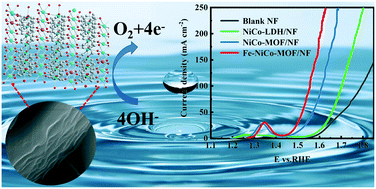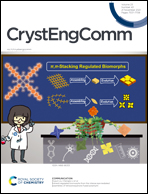In situ growth of an Fe-doped NiCo-MOF electrocatalyst from layered double hydroxide effectively enhances electrocatalytic oxygen evolution performance†
Abstract
Two-dimensional (2D) metal–organic frameworks (MOFs) with highly exposed electro-active surface are regarded as promising oxygen evolution reaction (OER) electrocatalysts. This work demonstrates the in situ conversion of NiCo-LDH (LDH: double-layer hydroxide) into an Fe-doped NiCo-MOF on a conductive substrate (Fe-NiCo-MOF/NF) by a two-step hydrothermal method. The hierarchical book-like structure of the Fe-NiCo-MOF/NF electrode provides a large electro-active surface and improved electron transport capability, leading to enhanced oxygen evolution performance in an alkaline environment. Specifically, Fe-NiCo-MOF/NF needs an overpotential of 290 mV to drive a current density of 50 mA cm−2, which is 136 mV lower than that of the precursor NiCo-LDH. Additionally, its activity can be maintained for at least 20 h at a high current density of 200 mA cm−2. Moreover, the real active centers of the catalyst were discovered to be the metal oxides converted during the OER cycles. This work used a simple hydrothermal method to enhance the OER performance, which is convenient for direct application of MOF materials in electrocatalysis fields.

- This article is part of the themed collection: Nanomaterials


 Please wait while we load your content...
Please wait while we load your content...